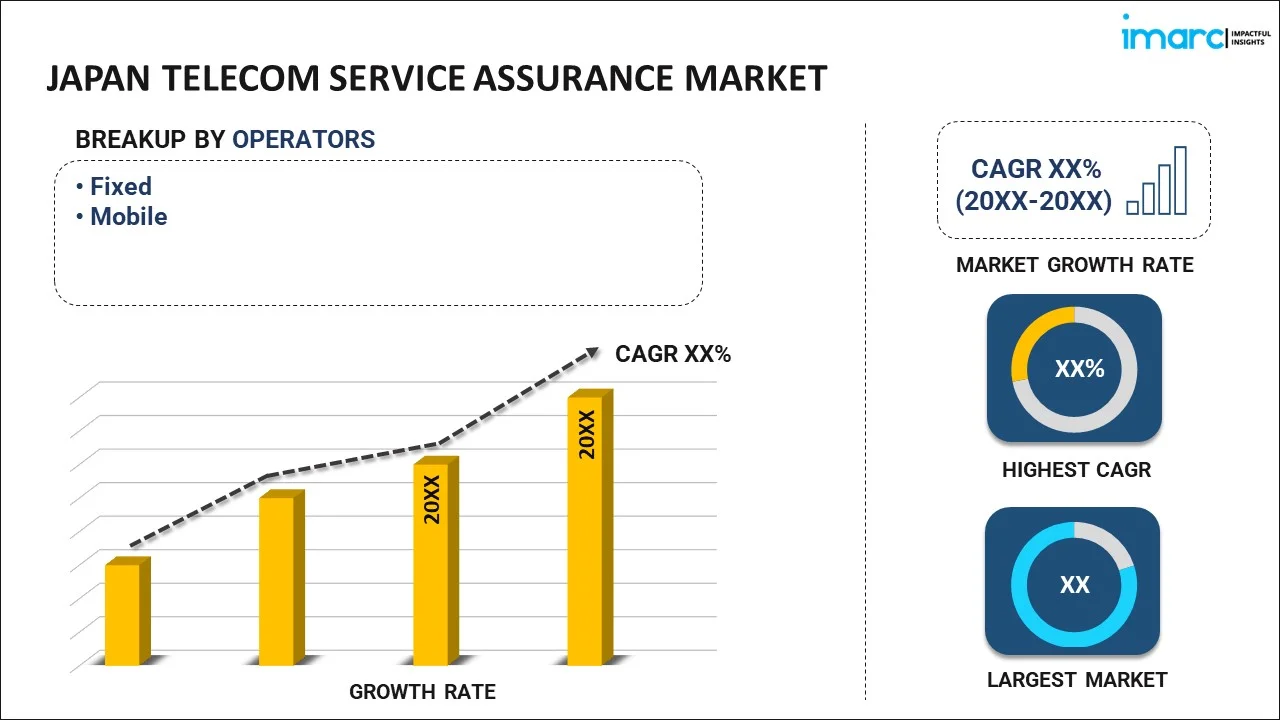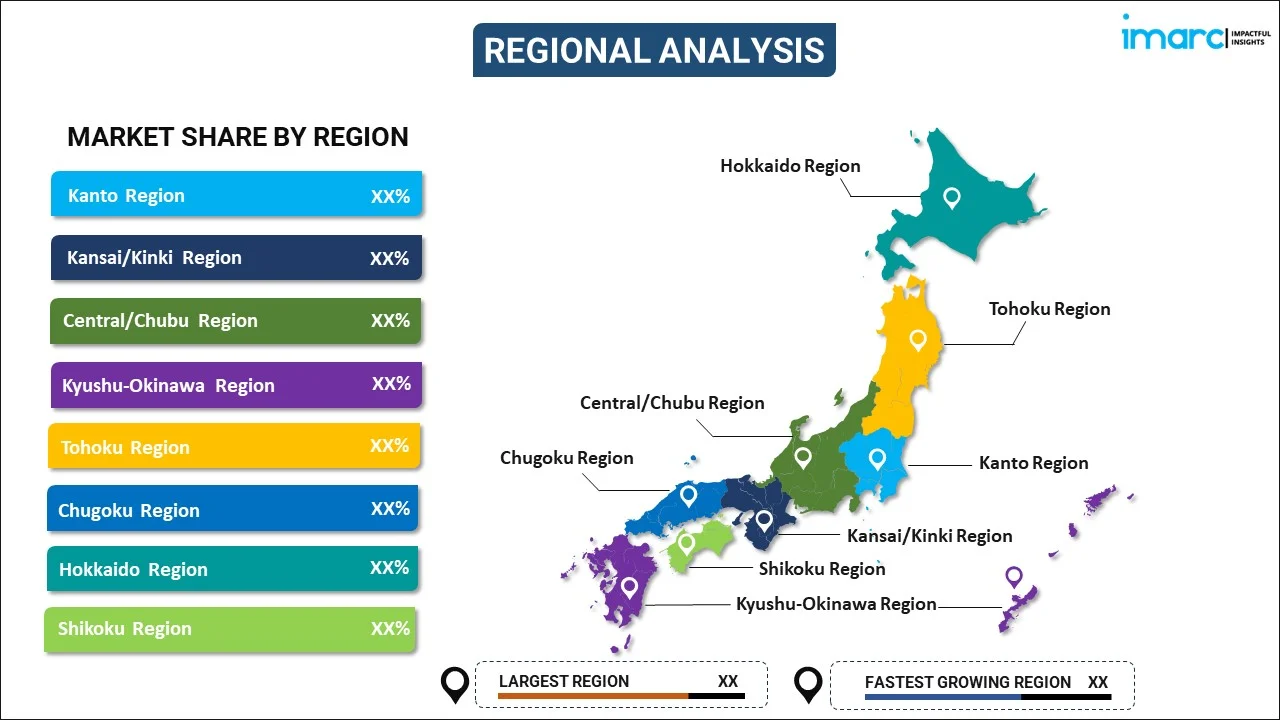
Japan Telecom Service Assurance Market Report by Operator (Fixed, Mobile), Solution (Software, Services), Deployment (On-premises, Cloud-based), Organization Size (Small and Medium-sized Enterprises, Large Enterprises), and Region 2026-2034
Market Overview:
Japan telecom service assurance market size reached USD 315.2 Million in 2025. Looking forward, IMARC Group expects the market to reach USD 652.6 Million by 2034, exhibiting a growth rate (CAGR) of 8.42% during 2026-2034. The market is being driven by several factors, including the growing intricacy of network infrastructures, which require thorough supervision and control, rising public apprehensions about security, a heightened emphasis on customer-centric strategies, and the integration of advanced technologies like 5G and the Internet of Things (IoT).
|
Report Attribute
|
Key Statistics
|
|---|---|
|
Base Year
|
2025 |
|
Forecast Years
|
2026-2034 |
|
Historical Years
|
2020-2025
|
| Market Size in 2025 | USD 315.2 Million |
| Market Forecast in 2034 | USD 652.6 Million |
| Market Growth Rate (2026-2034) | 8.42% |
Access the full market insights report Request Sample
Telecom service assurance is a strategic process employed by telecommunications service providers to guarantee the delivery of their services at optimal quality levels, aligning with customer expectations and industry benchmarks. This comprehensive approach encompasses a range of methodologies, tools, and solutions designed for the monitoring, management, and enhancement of service performance, quality, and availability. An integral element of contemporary telecommunication systems, service assurance offers valuable insights into network efficiency, allowing for the identification and mitigation of potential issues before they impact the user experience. Through continuous monitoring and intelligent data analysis, it empowers providers to detect inconsistencies or errors within the system, facilitating swift resolutions. Leveraging advanced techniques for data analysis and trend identification, these mechanisms ensure seamless operations, resulting in services characterized by reduced latency, heightened reliability, and superior quality.
Japan Telecom Service Assurance Market Trends:
The Japan telecom service assurance market is currently experiencing significant growth driven by several key factors. As telecommunication systems in the country continue to evolve and become more complex, the need for comprehensive oversight and management has become paramount. Telecom service assurance plays a pivotal role in ensuring that these evolving services are consistently delivered at optimal quality levels, aligning with both customer expectations and industry standards. One of the driving forces behind this market growth is the heightened focus on customer-centric approaches within the telecommunications sector. With customer experience becoming a top priority, service providers are increasingly relying on service assurance solutions to monitor and enhance the performance and quality of their services. This not only helps in meeting customer expectations but also boosts customer loyalty and retention. Moreover, the introduction of cutting-edge technologies such as 5G and the Internet of Things (IoT) has ushered in a new era of telecommunications, bringing with it both opportunities and challenges. Telecom service assurance is instrumental in managing these technologies, ensuring seamless operations, reduced latency, and higher reliability. Additionally, security concerns have become a paramount issue for both service providers and customers alike. Service assurance solutions aid in identifying and addressing security vulnerabilities, which is projected to fuel the regional market in the coming years.
Japan Telecom Service Assurance Market Segmentation:
IMARC Group provides an analysis of the key trends in each segment of the market, along with forecasts at the country level for 2026-2034. Our report has categorized the market based on operator, solution, deployment, and organization size.
Operator Insights:

To get detailed segment analysis of this market Request Sample
- Fixed
- Mobile
The report has provided a detailed breakup and analysis of the market based on the operator. This includes fixed and mobile.
Solution Insights:
- Software
- Services
A detailed breakup and analysis of the market based on the solution have also been provided in the report. This includes software and services.
Deployment Insights:
- On-premises
- Cloud-based
The report has provided a detailed breakup and analysis of the market based on the deployment. This includes on-premises and cloud-based.
Organization Size Insights:
- Small and Medium-sized Enterprises
- Large Enterprises
A detailed breakup and analysis of the market based on the organization size have also been provided in the report. This includes small and medium-sized enterprises and large enterprises.
Regional Insights:

To get detailed regional analysis of this market Request Sample
- Kanto Region
- Kansai/Kinki Region
- Central/ Chubu Region
- Kyushu-Okinawa Region
- Tohoku Region
- Chugoku Region
- Hokkaido Region
- Shikoku Region
The report has also provided a comprehensive analysis of all the major regional markets, which include Kanto Region, Kansai/Kinki Region, Central/ Chubu Region, Kyushu-Okinawa Region, Tohoku Region, Chugoku Region, Hokkaido Region, and Shikoku Region.
Competitive Landscape:
The market research report has also provided a comprehensive analysis of the competitive landscape in the market. Competitive analysis such as market structure, key player positioning, top winning strategies, competitive dashboard, and company evaluation quadrant has been covered in the report. Also, detailed profiles of all major companies have been provided.
Japan Telecom Service Assurance Market Report Coverage:
| Report Features | Details |
|---|---|
| Base Year of the Analysis | 2025 |
| Historical Period | 2020-2025 |
| Forecast Period | 2026-2034 |
| Units | Million USD |
| Scope of the Report | Exploration of Historical Trends and Market Outlook, Industry Catalysts and Challenges, Segment-Wise Historical and Future Market Assessment:
|
| Operators Covered | Fixed, Mobile |
| Solutions Covered | Software, Services |
| Deployments Covered | On-premises, Cloud-based |
| Organization Sizes Covered | Small and Medium-sized Enterprises, Large Enterprises |
| Regions Covered | Kanto Region, Kansai/Kinki Region, Central/ Chubu Region, Kyushu-Okinawa Region, Tohoku Region, Chugoku Region, Hokkaido Region, Shikoku Region |
| Customization Scope | 10% Free Customization |
| Post-Sale Analyst Support | 10-12 Weeks |
| Delivery Format | PDF and Excel through Email (We can also provide the editable version of the report in PPT/Word format on special request) |
Key Questions Answered in This Report:
- How has the Japan telecom service assurance market performed so far and how will it perform in the coming years?
- What has been the impact of COVID-19 on the Japan telecom service assurance market?
- What is the breakup of the Japan telecom service assurance market on the basis of operator?
- What is the breakup of the Japan telecom service assurance market on the basis of solution?
- What is the breakup of the Japan telecom service assurance market on the basis of deployment?
- What is the breakup of the Japan telecom service assurance market on the basis of organization size?
- What are the various stages in the value chain of the Japan telecom service assurance market?
- What are the key driving factors and challenges in the Japan telecom service assurance?
- What is the structure of the Japan telecom service assurance market and who are the key players?
- What is the degree of competition in the Japan telecom service assurance market?
Key Benefits for Stakeholders:
- IMARC’s industry report offers a comprehensive quantitative analysis of various market segments, historical and current market trends, market forecasts, and dynamics of the Japan telecom service assurance market from 2020-2034.
- The research report provides the latest information on the market drivers, challenges, and opportunities in the Japan telecom service assurance market.
- Porter's five forces analysis assist stakeholders in assessing the impact of new entrants, competitive rivalry, supplier power, buyer power, and the threat of substitution. It helps stakeholders to analyze the level of competition within the Japan telecom service assurance industry and its attractiveness.
- Competitive landscape allows stakeholders to understand their competitive environment and provides an insight into the current positions of key players in the market.
Need more help?
- Speak to our experienced analysts for insights on the current market scenarios.
- Include additional segments and countries to customize the report as per your requirement.
- Gain an unparalleled competitive advantage in your domain by understanding how to utilize the report and positively impacting your operations and revenue.
- For further assistance, please connect with our analysts.
 Request Customization
Request Customization
 Speak to an Analyst
Speak to an Analyst
 Request Brochure
Request Brochure
 Inquire Before Buying
Inquire Before Buying




.webp)




.webp)












